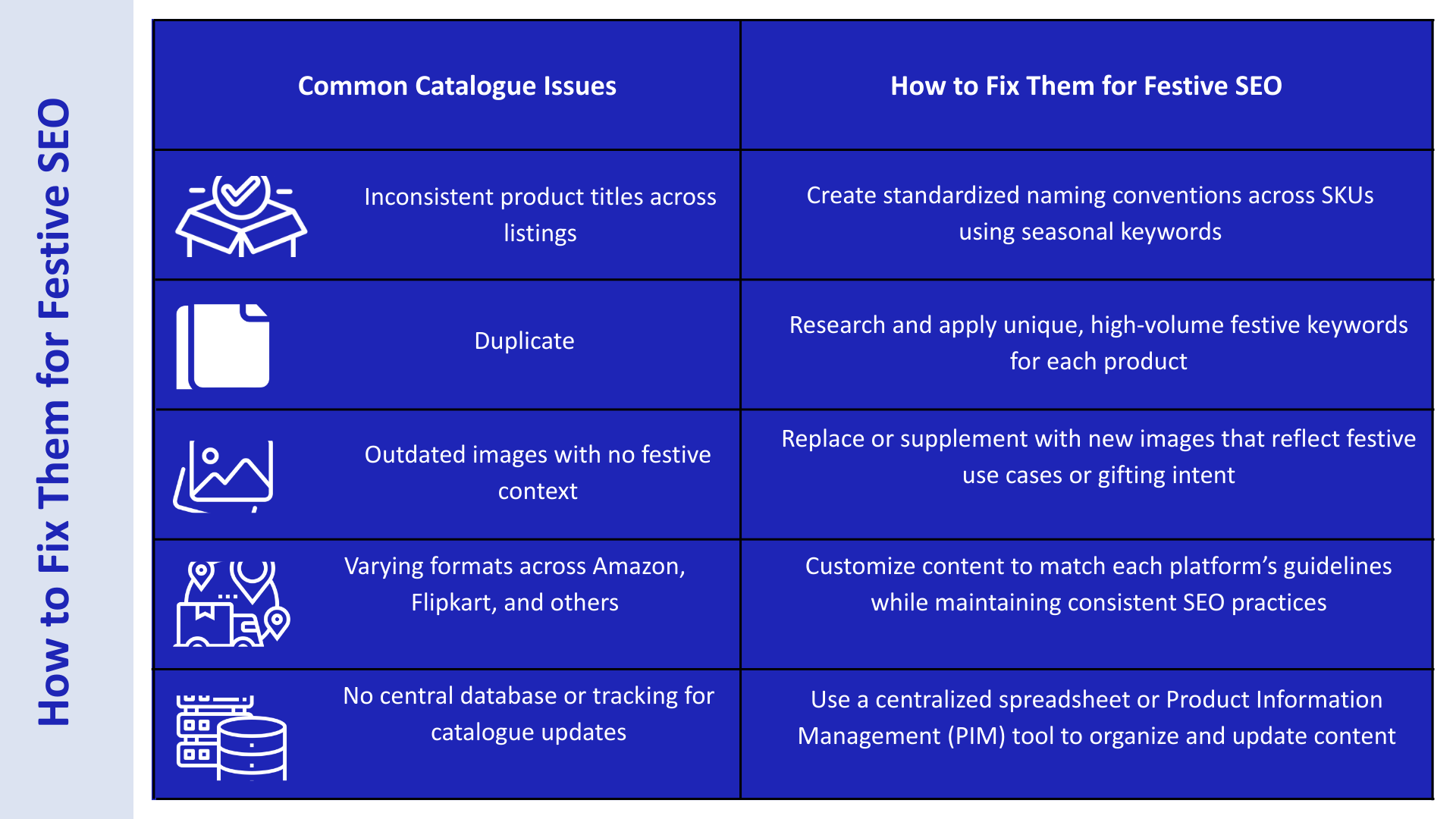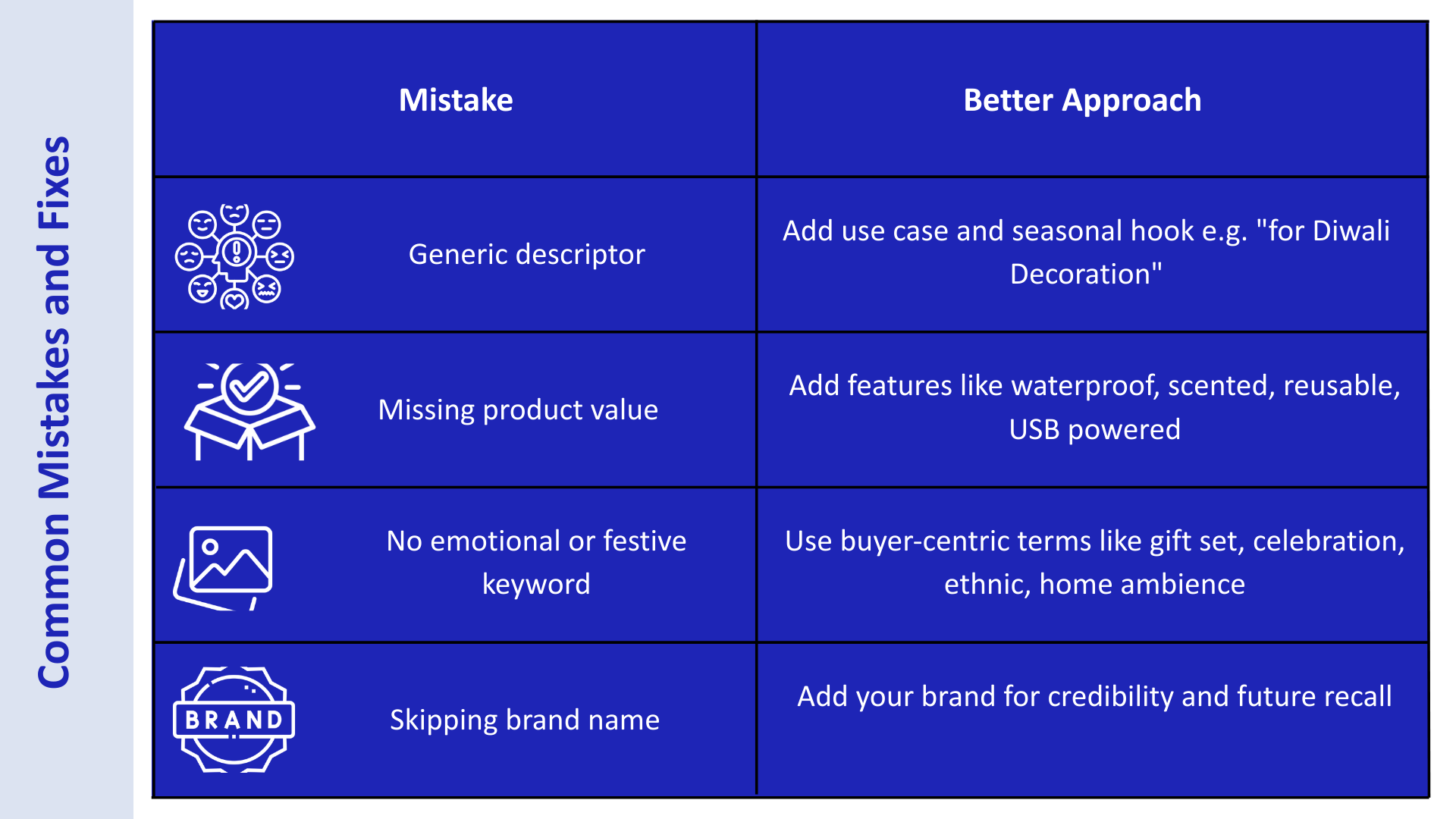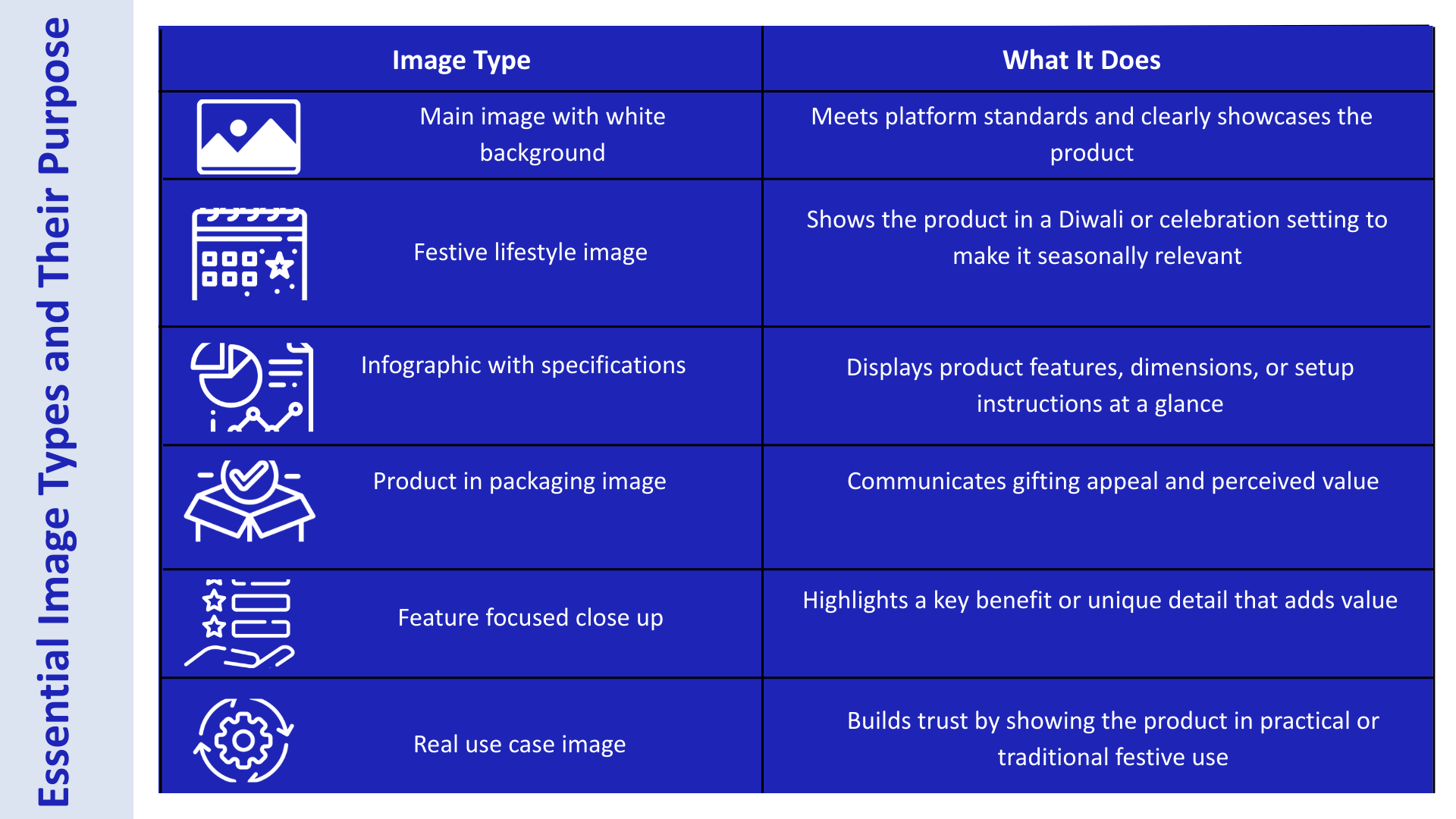
If you’re a D2C seller in India, the festive season is when everything ramps up – sales, traffic, competition, and opportunity. Whether it’s Diwali, Dussehra, or Christmas, shoppers flood platforms like Amazon and Flipkart looking for products that fit the occasion. This is your chance to grow your brand, reach new customers, and boost your revenue in a big way.
But there’s a catch: if your product doesn’t show up in the first click, you’re pretty much invisible. And during these high-traffic days, that can mean losing out on hundreds (or even thousands) of potential orders.
That’s why catalogue optimization is so important.
It’s not just about listing your product and moving on. It’s about writing your product titles in a way that customers are actually searching for. It’s about using keywords that match the season, adding photos that create a festive vibe, and making sure your product gets found when it matters most. The better your catalogue is set up, the higher your chances of ranking well, getting more clicks, and converting visitors into buyers.
Below are detailed catalogue optimization tips specifically tailored for festive sales cataloguing in India, built to help you rank higher, sell more, and outperform the competition.
1. Optimize for Festive SEO
During India’s festive season, platforms like Amazon and Flipkart witness a dramatic surge in shopper traffic. Consumers are actively searching for Diwali gifts, home décor, fashion, and more with high intent and a short purchase window. For D2C sellers, this should be a peak opportunity. But in reality, many brands miss out due to a hidden problem: fragmented cataloguing.
Fragmentation happens when your product data is scattered, inconsistent, or only partially updated across platforms. Some listings might include festive keywords while others do not. Some may feature fresh images, while others are still showing outdated packshots. This lack of uniformity prevents your listings from being properly optimized for festive SEO, which directly affects search rankings and conversion rates.
Buyers search using specific phrases like “Diwali gift box,” “LED festive lights,” or “ethnic kurta for puja.” If your listings don’t match that language across titles, bullet points, descriptions, and backend terms, your products may never be seen by those ready-to-buy customers.
Additional Optimization Tips
- Maintain a keyword density of 1.5 to 2 percent in each section including titles, bullet points, and product descriptions
- Use festive-specific words such as Diwali, gift, celebration, limited edition, festive deal, and more
- Ensure your product is optimized for both short keywords and long-tail festive search terms
- Tailor your listings to fit the platform. Amazon’s algorithm focuses heavily on keyword usage while Flipkart’s favors performance and visuals
Fixing catalogue fragmentation before the festive rush begins will help D2C sellers move faster, rank higher, and capture more sales during the most competitive shopping period of the year.
2. Craft Titles That Drive Both Ranking and Clicks
For D2C sellers, your product title is the single most important field during the festive season. It determines whether your product shows up in relevant search results and whether shoppers are compelled to click on it. While keyword placement is essential, a festive-ready title needs to do more than match search queries. It must also promise value and context in a crowded marketplace.
Why Most Titles Fail During Festive Sales
Many sellers either keep titles too generic or stuff them with too many keywords, making them hard to read. A title like “LED Light 10m Diwali Decoration Festival String for Home Office Gift Buy Now” looks messy, lacks structure, and turns buyers away. On the other hand, a title like “LED Light String” is too broad and doesn’t show festive relevance.
The festive shopper is looking for relevance and inspiration. If your title can mirror their search intent and offer a quick mental image of how the product fits into their Diwali plans, you’re more likely to earn the click.
Advanced Tips to Craft Better Titles
- Use buyer-facing keywords like “ready to gift” or “festive essential”
- Begin with the strongest identifier (e.g. “10m LED Fairy Light for Diwali”)
- Include only the most relevant attributes to avoid clutter
- Keep it readable on mobile – think clarity, not just completeness
A strong festive title does three jobs in one: it helps the algorithm understand your product, tells the shopper it matches their intent, and gives them a reason to trust and click.
3. Write Bullet Points That Sell and Rank
In festive shopping, attention spans are short. Shoppers scroll fast, compare quickly, and often make snap decisions. That is why your bullet points must do two things well: improve your product’s visibility through keywords and convince buyers to choose your product over others.
Each bullet point is a strategic space to include a keyword, highlight a key feature, and show a festive benefit.
Structure Your Bullet Points Like This:
- Feature plus festive benefit: Example: Energy Efficient LEDs that keep your home beautifully lit this Diwali without increasing electricity costs
- Material and quality claims: Highlight premium build, finish, or packaging especially for gifting
- Festive use case: Mention occasions like Diwali, Navratri, pooja setups, or festive home decor
- Gifting appeal: Use lines like Perfect for Diwali gifting or Comes in gift ready packaging
- Support and trust builders: Include details like warranty, quick support, or hassle free returns to build buyer confidence
Make sure every bullet includes at least one seasonal keyword to boost your catalogue SEO for the festive season. Well-written bullet points are often the reason a buyer clicks Add to Cart instead of continuing to scroll.
4. Use High Quality Festive Themed Images
Your product images play a critical role in driving clicks and conversions during the festive season. Platforms like Amazon and Flipkart prioritize listings that perform well in both areas. Better images mean better engagement, which improves your ranking during high traffic festive sales events.
For D2C sellers, this is a major opportunity. Festive shoppers are looking for emotion, celebration, and presentation. Your images should not just show the product—they should help the customer imagine it in their home or as a gift. Visual storytelling becomes essential.
Best Practices for Festive Product Galleries
- Use traditional elements like diyas, lights, ethnic fabrics, or gift wraps to add festive cues
- Maintain a clean, focused look with the product at the center of attention
- Ensure all images are high resolution and optimized for mobile viewing
- Keep lighting warm and consistent to match the tone of the season
- Avoid adding too much text on images, but use icons and labels where necessary
Do not underestimate the power of visual impact. A single festive themed image can make your product feel more relevant and desirable. It helps customers connect emotionally, especially during Diwali or other celebrations when presentation matters as much as the product itself.
5. Tailor Your Listings for Each Marketplace
Every online marketplace has its own algorithm, content rules, and shopper behavior. What works on Amazon might not work on Flipkart, and vice versa. During the festive season, these differences become even more important as both platforms launch large scale promotions and buyer traffic peaks.
As a D2C seller, it is essential to customize your product listings to match each platform’s unique ranking system and buyer expectations.
Key Marketplace Differences and What to Do
| Marketplace | What It Prioritizes | How to Optimize for Festive Season |
|---|---|---|
| Amazon | Search relevance, backend keywords, fulfillment method | Use exact match festive keywords in title and backend fields. Leverage Fulfilled by Amazon to boost Prime visibility and delivery trust. |
| Flipkart | Product ratings, visuals, and sales momentum | Focus on high quality images and competitive pricing. Activate festive deals early to build traffic and ranking. |
| Meesho | Price sensitivity, trending tags, fast moving SKUs | Use trending festive tags and emphasize low price with value in the description. |
| Jiomart | Local appeal, basic details, and trust signals | Keep listings clear and use festive regional keywords like Diwali puja or Navratri gift. |
Additional Marketplace Specific Tips
- On Amazon, run festive coupons and sponsored ads targeting festival terms like Diwali gift or home decor ideas
- On Flipkart, make sure your product appears in festive collections by participating in campaigns like Big Billion Days
- On both platforms, monitor daily performance reports and update listings as needed based on CTR, search rank, and conversion
Tailoring your content for each platform ensures that your listings are not only compliant, but also competitive. A one size fits all approach limits your festive reach. By understanding the platform’s behavior, you can align your catalogue to outperform other sellers during peak festive traffic.
Fix Your Catalogue First: The Festive Sales Growth Base
Struggling with low festive sales? The real problem might be a fragmented catalogue. Incomplete titles, missing festive keywords, outdated images, and inconsistent listings can keep your products buried in search results during high-traffic periods like Diwali and Dussehra.
The base of a strong festive sales strategy is a clean, centralized, and optimized catalogue. Use a product management tool to update all content. Add seasonal keywords like Diwali gift set in titles, use clear bullet points with festive use cases, and refresh images with celebration-focused visuals and packaging shots.
Tailor your listings for each platform. Amazon rewards keyword precision, Flipkart favors strong visuals, and Meesho looks for trending festive tags. Apply the same optimized structure across all new SKUs to maintain consistency.
A well-optimized catalogue is not a small task, it is the base that drives visibility, clicks, and conversions during the most competitive sales season of the year. Fix the foundation, and festive growth will follow.
Centralize your catalogue with Base.com to manage all SKUs from one platform and eliminate festive season hassles. Click here to get started.
Frequently Asked Questions
Q1. How does catalogue centralization help during festive sales?
Catalogue centralization means maintaining one clean, updated product database for all platforms. It eliminates fragmentation where some listings are festive-ready and others outdated. With a central catalogue, sellers can bulk update festive keywords, pricing, and images consistently across Amazon, Flipkart, Meesho, and Jiomart. This ensures uniform discoverability, faster updates after GST or seasonal changes, and better festive SEO.
Q2: How can you increase 100 percent sales?
To double your sales, improve catalogue consistency across all platforms. Use festive keywords like Diwali gift set and home decoration. Upgrade images to show festive use and add emotional appeal. Offer bundled products and gift packs. Run targeted ads, apply discounts, and highlight fast delivery. Optimize backend search terms and titles for better discovery. A clean, festive-ready catalogue with value driven content and deals can significantly boost conversion and repeat purchases.
Q3. How should D2C sellers centralize their festive catalogue?
Use a centralized spreadsheet or Product Information Management (PIM) tool to track product titles, festive keywords, images, and backend data. Apply consistent naming conventions like “Diwali Gift Box – Brand Name.” Upload new festive images across platforms simultaneously. Standardization ensures festive readiness, reduces duplication, and improves catalogue health scores on Amazon and Flipkart.




